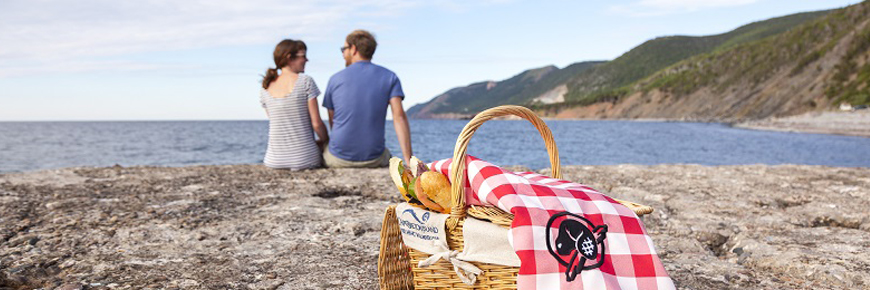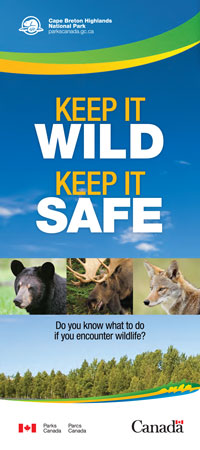
Keep it wild, keep it safe
Cape Breton Highlands National Park
Observing wildlife can be the highlight of your visit to a national park. Wild animals usually keep their distance. However, wildlife are unpredictable and have been known to cause serious injury and even death to humans. They may threaten and attack people when they become accustomed to humans, when they are surprised or when they are forced to defend themselves, their young or their food.
Do you know what to do it you encounter wildlife?
Download our wildlife safety brochure, "Keep It Wild, Keep It Safe" (PDF, 1.85 MB)
Reduce your risk
Stay alert!
Watch for wild animals and their young. Leave the area if you see fresh signs or feeding areas such as large berry patches or carrion (dead animals). Bears and coyotes can be very protective of food sources.
Make noise and be visible
Let wild animals know you're there—especially near streams, on windy days and in areas of low visibility. Animals can be unpredictable if surprised.
Never approach
Keep a distance of three bus lengths (30 m / 100 ft). Take a wide detour if you have to. Wildlife may become aggressive if they feel threatened.
Hike with friends and a solid walking stick during daylight hours. Consider bringing bear spray, a whistle and/or an air horn. Keep children close by.
Tell someone where you're going.
Ride or run in groups
Cycling and running have been known to incite a chase response in coyotes and bears. You are safer travelling in a group.
Do not feed animals, even indirectly through littering or throwing food scraps in the woods. Animals that have access to our food or garbage lose their fear of people and are more likely to be dangerous. Animals that have been fed, directly or indirectly, may later approach other unsuspecting visitors in search of food, putting them in danger.
Keep food smells to a minimum by properly storing food, garbage and food-related items such as packaging, dishes and coolers. Artificial scents (soap, lotions, toothpaste, etc.) can also attract wildlife. Dispose of cooking water in sinks, not on the ground.
Keep your dog on a leash
Dogs may trigger an attack and then come running back to you with a wild animal in pursuit.
Black bears

Black bear attacks are extremely rare. However, bear encounters in North America are on the rise. Being prepared is key to personal safety.
If you see a bear
- Remain calm and observe its behaviour. Does it have cubs? Is it protecting food? How far away is it? Does it have an escape route?
- Do not look directly at the bear
- Talk in a low tone and walk away slowly, still facing the bear
- Do not run; do not climb a tree
- Do not feed
If a bear approaches you
- Get bear spray ready
- Make yourself large, make noise, throw rocks
- If in a group, gather together
- Stand up to the bear
- If the bear approaches within 7 metres (25 ft), use bear spray
Black bear attacks
There are two types of attacks: defensive and predatory. Recognizing each type will help you react appropriately.
Defensive bears are protecting food or cubs. They may huff or clack their jaw, bluff charge and/or swing their head from side to side. Predatory bears stalk quietly, or attack at night.
If a bear attacks
Defensive attack:
- Use bear spray
- Do not run or turn - stand up to the bear
- Raise your arms; make yourself large
- If the bear knocks you down, play dead
- Protect your head and neck with hands and arms
Predatory attack:
- Use bear spray
- Do not run or turn - stand up to the bear
- Raise your arms; make yourself large
- If the bear knocks you down, do not play dead
- Fight with whatever you have
Coyotes

Most coyotes run away before you see them. However, in certain areas such as trails, roads and campgrounds, they may become habituated to people or to human food or garbage. Habituated coyotes lose their natural fear of people and have been known to be dangerous.
If a coyote approaches you
- Do not run. Running can incite a chase response. Coyotes can run up to 65 km/h (40 mph)
- Remain calm
- Do not turn your back
- Make yourself large and loud
- Attempt to drive the coyote away
- Do not feed
If a coyote attacks
- Fight back
- Shout, throw stones and use whatever is available to defend yourself
- Do not play dead
- Report your encounter immediately to Parks Canada staff, or call 1-877-852-3100
Moose

Moose may look tame, but they are not. They have been known to charge people and vehicles and can attack with their hooves.
- Cow moose are most dangerous during calving season (mid-May to the end of June)
- Bull moose can be more aggressive during mating season (mid-September to the end of December)
- In late winter, moose may be reluctant to leave the road or trail and may defend their space aggressively
Watch for moose while driving
Moose commonly run across the road - and sometimes stand in the middle of it. They can be very hard to see, especially at dusk or if they are not facing you. Avoid a collision: scan the roadside for wildlife, drive within the posted speed limit, and avoid driving after dusk.
Stay at least 3 bus lengths away (30 m / 100 ft), whether driving or on foot. On the trail, wait for the moose to leave, take a wider detour if necessary and always keep a tree or other large obstacle between you and the moose.
Signs of an aggressive moose
- Ears pinned back
- Hair on neck raised
- Mouth smacking and licking
- Foot stomping
- Swaying head
- Short charges
If a moose charges
- Find protection and get behind it
- Trees or large rocks can serve as a barrier
- If you get knocked down by a moose, curl up into a ball and protect your head and neck
- Report encounters with agitated or aggressive moose immediately to Parks Canada staff or call 1-877-852-3100
Carcasses
Predators, such as bears and coyotes, often feed on animal remains. If you see or smell a carcass, be extra vigilant and move away from the area. You are encouraged to report it to Parks Canada staff by calling 1-877-852-3100.
Parks Canada staff dispose of the remains of large animals (who die naturally or from a collision with a vehicle) in areas not normally used by visitors. Heed posted notices and stay out of these areas.
- Date modified :
